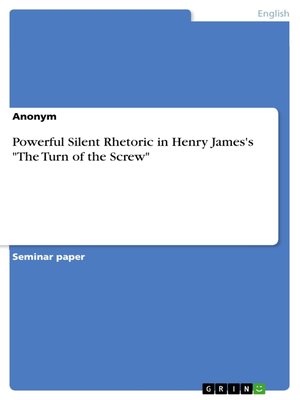
Sign up to save your library
With an OverDrive account, you can save your favorite libraries for at-a-glance information about availability. Find out more about OverDrive accounts.
Find this title in Libby, the library reading app by OverDrive.



Search for a digital library with this title
Title found at these libraries:
| Loading... |
Seminar paper from the year 2005 in the subject English Language and Literature Studies - Literature, grade: 1,0, Johannes Gutenberg University Mainz, language: English, abstract: Hardly any other story has provoked as many different readings as Henry James's The Turn of the Screw. The novella causes an extremely strong impact on its reader, dividing its interpreters in various camps: "If the ghosts of The Turn of the Screw are not real, certainly the controversy over them is."1 As Parkinson states, the history of the text's criticism is strongly dominated by the apparitionists/non-apparitionists, or ghost/non-ghost readers,2 but even though critics have ambitiously tried to unite these different approaches, a final fusion could not be found. This effect is caused by the text's ambiguity, James's distinctive erotic stylistic, but also by the trick the author plays on his audience, since, while interpreting, the reader is simultaneously forced to participate in the story and thus in the scandal of the story itself. As Felman puts it, the reader cannot stay innocent.3 My approach is therefore not to find the ultimate solution why one reading must be considered superior to another one (since there is none), but rather to maintain this duality and to concentrate on the overall function of the text. By placing it within the historical context in which it was written and, thereby, focusing strongly on the aspects of sexuality in nineteenth-century American society, especially on the famous Oscar Wilde trials taking place shortly before James published his novella, I try to capture why the text causes so many different readings, how the seduction of the interpreter works, and, eventually, what this impossibility of an overall reading actually means, considering the historical context James was to witness. The question I am eager to answer is on what is said about the very act of decoding ambiguity, about the process of interpretation, which can literally be found in the story itself. "Wilde Times": Sexuality in Nineteenth-Century America
James's fiction "anatomizes the key structures of sexuality per se."4 Consequently, it is inevitable to take into consideration the crucial notions of sexuality and sexual identities accumulating in nineteenth-century American society before setting out to explore James's novella. First of all is it noteworthy to refer to the fact that, as Halperin correctly states, "we live in the prominence of heterosexuality and homosexuality as central, organizing categories of thoughts, behavior, and erotic subjectivity," whereas "human beings in the past might have had radically different...






